This post may contain affiliate links.
Maqluba is a popular Middle Eastern dish that combines rice, vegetables, and meat. One of the unique things about this dish is how it is carefully layered, cooked, then flipped upside down to reveal what’s inside.
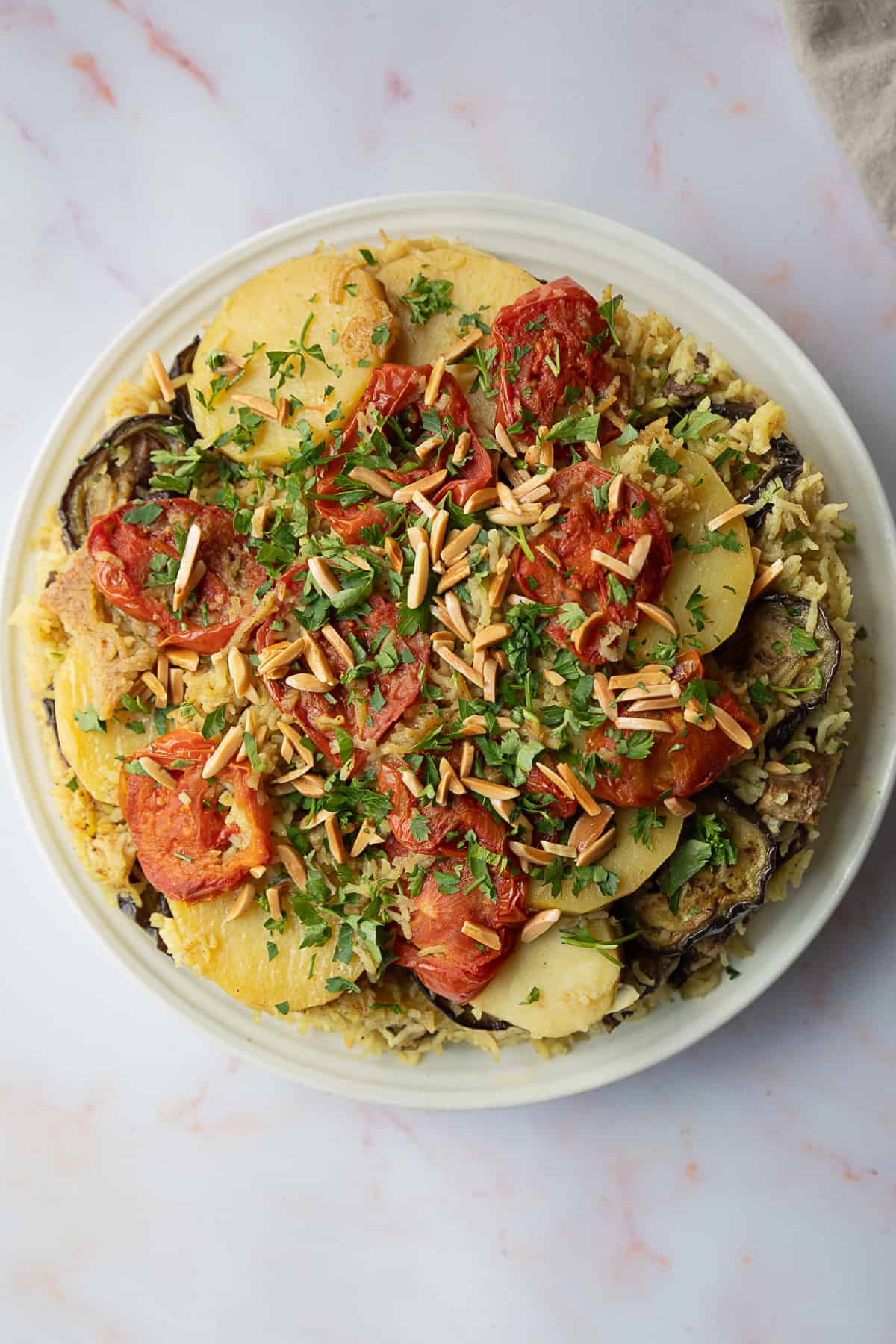
Maqluba (also spelled maklaubeh, maklauba, maklaubaa) is an Arabic dish that means upside down. It consists of layers of vegetables like onions, tomatoes, potatoes, eggplant and/or cauliflower, seasoned beef, chicken or lamb, and spiced broth. After layering the ingredients in the pot, it is flipped over to reveal what looks like a rice cake. Maqluba is a traditional recipe that takes time to prepare but is well worth the effort!
Explore additional Middle Eastern rice recipes that you will love, such as Middle Eastern Chicken And Rice Recipe, Sabzi Polo (Persian Herb Rice), Albaloo Polo (Persian Sour Cherry Rice), and Easy Lebanese Rice with Vermicelli.
Table of Contents
Recipe Highlights
Cultural Influence: Levantine
Preparation Technique: Layering
Dietary Info: Gluten-free, could be made vegetarian
Signature Taste: Rich and savory
Skill Level Required: Medium
What Is Maqluba?
Maqluba, also spelled as maqlooba, makloubeh, or maqlouba, is a traditional Middle Eastern dish with deep roots in the culinary heritage of the Arab world.
The name “maqluba” translates to “upside-down” in Arabic, which aptly describes the dish’s distinctive presentation. The beauty of maqluba lies in its final appearance—a visually striking “rice cake” adorned with vibrant layers of vegetables, flavorful beef or chicken, and fragrant spiced rice.
Historically, maqluba was a dish prepared for special occasions and celebrations, such as weddings, festivals, and family gatherings. Its impressive presentation and rich flavors made it a centerpiece of celebrations, symbolizing warmth, hospitality, and togetherness.
History of Maqluba
The history of maqluba traces back centuries within the Levantine region, encompassing present-day Palestine, Jordan, Lebanon, and Syria. While specific origins are challenging to pinpoint, Maqluba’s roots are deeply intertwined with the cultural heritage and culinary traditions of the Middle East.
Over time, Maqluba spread across the Middle East, gaining popularity in countries like Jordan, Lebanon, Syria, and beyond. Each region added its own unique twist to the dish, incorporating local ingredients and spices to create distinct variations while preserving its essence.
Today, Maqluba remains a beloved staple in Middle Eastern cuisine. It continues to evoke feelings of nostalgia and tradition, bringing people together to share in the joy of good food and cherished memories.

Why You’ll Love Maqluba
Flavorful: Maqluba is packed with flavor, thanks to the fragrant spices and the traditional layering method.
Unique presentation: The distinctive layering and flipping process of maqluba adds an element of surprise and excitement to mealtime, making it a memorable dish to enjoy with family and friends.
Easy to Make: Despite its authentic flavors and traditional layering method, Maqluba is surprisingly easy to make. The recipe involves simple steps of roasting vegetables, cooking lamb, and layering these with rice.
Versatile and Adaptable: Maqluba offers endless possibilities for customization to suit individual tastes and preferences. From selecting the perfect blend of spices to deciding which vegetables to include or omit, this dish allows for creative freedom in the kitchen.

Key Ingredients
- Lamb: Bone-in lamb provides rich flavor and adds depth to the dish. Use high-quality lamb for optimal taste and texture.
- Seasonings: Aromatic spices like cinnamon, cardamom, and bay leaves enhance the flavor.
- Onion: Onions add a depth of flavor that complements the richness of lamb.
- Olive oil: You’ll need olive oil for browning the lamb in olive oil and spices and for sautéing the vegetables.
- Water: You will need water for cooking the lamb.
- Eggplants: Look for firm eggplants with glossy skin.
- Potatoes: Yukon Gold potatoes have a creamy texture and a slightly buttery flavor, which adds richness and depth to the dish. When cooked in Maqluba, they become tender and velvety, complementing the other ingredients perfectly.
- Tomatoes: Tomatoes add juiciness and color to your maqluba.
- Basmati Rice: Basmati rice is preferred for its fragrant aroma and fluffy texture.
- Salt: Add salt to taste
- Spices: Add 7 spices and turmeric for vibrant flavor and color.
- Slivered Almonds: Slivered almonds add crunch and nuttiness.
- Parsley: Fresh parsley adds a vibrant pop of color to the dish, contrasting beautifully with the earthy tones of the rice, meat, and vegetables.
How to Make Maqluba
Step 1: Prepare the Lamb
Heat 1 tablespoon of olive oil in a large pot over medium-high heat. Sear the lamb pieces on all sides until golden brown, approximately 3-4 minutes per side.

Add the cinnamon stick, cardamom pods, bay leaves, onion (halved or quartered), salt, and pepper to the pot. Pour in 6 cups of water to cover the lamb.

Bring the mixture to a simmer, then reduce the heat to low and cover the pot. Cook the lamb for 1.5 to 2 hours, or until it is tender and fully cooked, occasionally skimming off any foam that rises to the surface.

Step 2: Roast the Eggplant and Potatoes
Preheat the oven to 425°F (220°C). In a large bowl, toss the sliced eggplant and Yukon Gold potatoes with 3 tablespoons of olive oil until evenly coated.
Arrange the seasoned eggplant and potatoes in a single layer on a baking sheet.

Roast in the preheated oven for 30 minutes, or until the vegetables are tender and lightly browned, turning them halfway through the cooking time for even browning.

Step 3: Arrange the Layers in the Pot
Lightly oil the bottom of a large pot or Dutch oven. Arrange the sliced tomatoes in an even layer at the bottom of the pot.

Layer the roasted potatoes.

Then, layer the eggplant.

Then add the cooked lamb pieces.

Spread the rinsed and drained basmati rice evenly over the lamb.

Sprinkle the top layer of rice with the 7-spice blend, salt, and turmeric.

Step 5: Add Lamb Stock and Simmer
Pour 5 cups of the reserved lamb stock (from cooking the lamb) over the layers in the pot, ensuring that the liquid covers the rice by approximately 1 inch. Make sure the rice is patted tight.

Bring the pot to a gentle simmer over medium heat, then cover with a tight-fitting lid. Cook the maqluba for 50 minutes, or until the rice is cooked through and the liquid has been absorbed. Remove the pot from the heat and let it sit, covered, for an additional 15 minutes to allow the flavors to meld.
Step 6: Flip and Serve
Carefully run a knife around the edges of the pot to loosen the maqluba.
Place a large serving platter or plate over the top of the pot. Holding the platter and pot securely together, quickly flip them upside down to release the maqluba onto the platter. Remove the pot carefully, allowing the layers of maqluba to settle onto the platter.

Garnish the maqluba with toasted slivered almonds and chopped parsley, if desired.

What To Serve With Maqluba
Maqluba is a hearty and flavorful dish that pairs well with a variety of sides and accompaniments. Here are some options to serve alongside maqluba:
- Tabouli Salad Recipe (Tabbouleh)
- Fattoush Salad Recipe
- Easy Homemade Hummus Recipe
- Creamy Cucumber Salad With Yogurt

Tips, Tricks, and Hacks
- Prep Ingredients Ahead of Time: Prepare all your ingredients before starting to cook. This includes slicing vegetables, trimming meat, and measuring out spices. Having everything ready will make the cooking process smoother.
- Slice Vegetables Evenly: Before roasting, ensure that both the eggplants and Yukon Gold potatoes are sliced into uniform thickness. Evenly sliced vegetables will cook at the same rate, ensuring that they are tender and evenly caramelized.
- Brown the Meat Well: When browning the lamb, ensure it develops a deep golden-brown color. This caramelization adds richness and depth of flavor to the dish.
- Layer Ingredients Evenly: Layer the ingredients evenly in the pot to ensure even cooking. Distribute the meat, vegetables, and rice evenly to create a balanced dish.
- Press Layers Down: After adding each layer, gently press it down with a spatula or the back of a spoon. This helps to compact the layers and ensures the Maqluba holds together when flipped.
- Use a Heavy-Bottomed Pot: Choose a heavy-bottomed pot or Dutch oven for cooking Maqluba. This helps distribute heat evenly and prevents the bottom from burning.
- Cook Over Low Heat: Cook maqluba over low heat to allow the flavors to develop slowly and evenly. Avoid rushing the cooking process to prevent burning or uneven cooking.
- Rest Before Flipping: Allow the maqluba to rest for a few minutes before flipping it onto a serving platter. This helps the layers set and makes flipping easier.
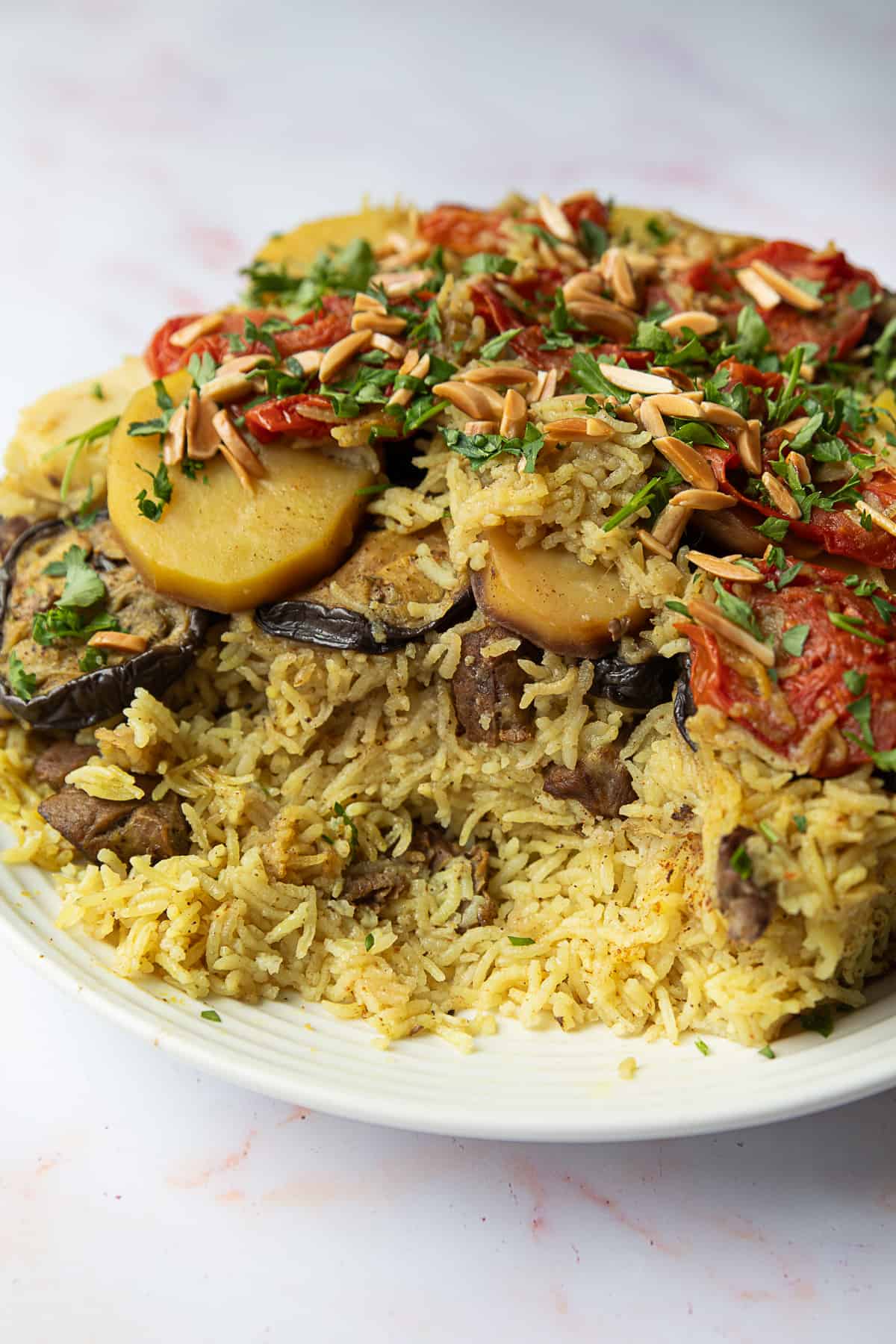
Variations and Substitutions
Cauliflower Florets Addition: Some variations include roasted or fried cauliflower florets alongside the potatoes. They add texture and absorb flavors beautifully.
Chicken Maqluba: For a chicken variation of maqluba, simply substitute the meat with chicken pieces (preferably skinless thighs and legs), ensuring they are cooked thoroughly alongside the rice and vegetables. The result is a delightful twist on the traditional dish, offering a lighter option without compromising on flavor.
Vegetarian/Vegan Maqluba: Replace the meat with plant-based proteins such as chickpeas, lentils, or tofu. You can also add a variety of vegetables, like carrots, bell peppers, zucchini, or cauliflower to enhance the dish’s flavor and texture.
Spices: You can add different spices to maqluba according to your taste preferences. Cumin, coriander, cloves, nutmeg, and cinnamon are great choices too.
Customized Garnishes: Experiment with different garnishes such as toasted pine nuts, dried raisins, or fresh herbs (parsley, cilantro) to add texture and flavor to Maqluba.

Storage
Refrigeration: Transfer the cooled maqluba into an airtight container. Make sure the container is large enough to accommodate the dish without crushing the layers. Place the container in the refrigerator and store it for up to 3-4 days.
Freezing: If you want to store maqluba for longer periods, you can freeze it. Divide the maqluba into individual portions and store them in freezer-safe containers or zip-top bags. Freeze for up to 2-3 months.
Thawing and Reheating: When ready to eat, thaw frozen maqluba in the refrigerator overnight. Reheat it gently in the microwave or oven until heated through. Adding a splash of water or broth can help prevent it from drying out during reheating.
Frequently Asked Questions
Yes, maqluba can be made ahead of time and reheated before serving. However, it is best served fresh for optimal flavor and texture.
Maqluba is traditionally served family-style, with the pot flipped upside down onto a large serving platter to reveal the layers of meat, vegetables, and rice. It is often garnished with toasted nuts and fresh herbs before serving.
Despite its authentic flavors and traditional layering method, this maqluba recipe is surprisingly easy to prepare. The key lies in using quality ingredients and mastering the layering technique.
Basmati rice is traditionally used in maqluba for its fragrant aroma and fluffy texture. However, you can also use other varieties of long-grain rice depending on personal preference.
To prevent sticking, ensure the bottom layer of the pot (consisting of tomatoes) is evenly arranged, and the pot is adequately oiled. Additionally, opt for a heavy-bottomed pot, such as a Dutch oven, to evenly distribute heat.
If the rice isn’t fully cooked or seems dry, it may require additional liquid. Try adding a little more water or broth to the pot. Once you’ve added more liquid, continue cooking the maqluba on low heat for an additional 5-10 minutes. This allows the rice to absorb the extra liquid and cook further.

Did you make this recipe? I’d love to hear about it! Please comment and leave a 5-star🌟 rating below. You can also follow us on Instagram, Facebook, Pinterest or subscribe to our newsletter to get a free e-Cookbook!
Other Middle Eastern Recipes You Must Try:
Vegetarian
Ful Medames Recipe (Egyptian Fava Beans)
Vegetarian
The Best Middle Eastern Eggplant Recipe
Mediterranean recipes
Zaatar Manakish (Manakeesh)
Mediterranean recipes
Easy Homemade Hummus Recipe
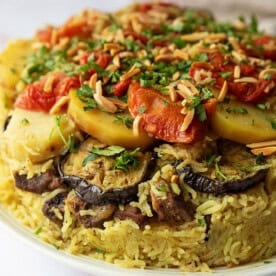
Maqluba Recipe
Ingredients
Lamb
- 1 tablespoon olive oil
- 1½ pounds lamb, bone-in
- 1 cinnamon stick
- 4 cardamom pods
- 2 bay leaves
- 1 onion
- salt and pepper, to taste
- 6 cups water
Vegetables
- 2 Italian eggplants, sliced ½ inch thick
- 2 yukon gold potatoes, sliced ½ inch thick
- 3 tablespoons olive oil
- 2 tomatoes, sliced
- 2 cups basmati rice
- 1 teaspoon seven spice
- 1 teaspoon kosher salt
- ½ teaspoon turmeric
Garnish
- Slivered almonds, toasted
- Chopped parsley
Instructions
Prepare the Lamb
- Heat 1 tablespoon of olive oil in a large pot over medium-high heat. Sear the lamb pieces on all sides until golden brown, approximately 3-4 minutes per side.
- Add the cinnamon stick, cardamom pods, bay leaves, onion (halved or quartered), salt, and pepper to the pot. Pour in 6 cups of water to cover the lamb.
- Bring the mixture to a simmer, then reduce the heat to low and cover the pot. Cook the lamb for 1.5 to 2 hours, or until it is tender and fully cooked, occasionally skimming off any foam that rises to the surface.
Roast the Eggplants and Potatoes
- Preheat the oven to 425°F (220°C). In a large bowl, toss the sliced eggplant and Yukon Gold potatoes with 3 tablespoons of olive oil until evenly coated.
- Arrange the seasoned eggplant and potatoes in a single layer on a baking sheet. Roast in the preheated oven for 30 minutes, or until the vegetables are tender and lightly browned, turning them halfway through the cooking time for even browning.
Arrange the Layers in the Pot
- Lightly oil the bottom of a large pot or Dutch oven. Arrange the sliced tomatoes in an even layer at the bottom of the pot.
- Layer the roasted potatoes and eggplant over the tomatoes, followed by the cooked lamb pieces. Spread the rinsed and drained basmati rice evenly over the lamb. Sprinkle the top layer of rice with the 7 spice blend, salt, and turmeric.
Add Lamb Stock and Simmer
- Pour 5 cups of the reserved lamb stock (from cooking the lamb) over the layers in the pot, ensuring that the liquid covers the rice by approximately 1 inch. Make sure the rice is patted tightly.
- Bring the pot to a gentle simmer over medium heat, then cover with a tight-fitting lid. Cook the Maqluba for 50 minutes, or until the rice is cooked through and the liquid has been absorbed. Remove the pot from the heat and let it sit, covered, for an additional 15 minutes to allow the flavors to meld.
Flip and Serve
- Carefully run a knife around the edges of the pot to loosen the Maqluba.
- Place a large serving platter or plate over the top of the pot. Holding the platter and pot securely together, quickly flip them upside down to release the Maqluba onto the platter. Remove the pot carefully, allowing the layers of Maqluba to settle onto the platter
- Garnish the Maqluba with toasted slivered almonds and chopped parsley, if desired.
Video
Notes
-
- If the rice isn’t fully cooked or seems dry, it may require additional liquid. Try adding a little more water or broth to the pot. Once you’ve added more liquid, continue cooking the maqluba on low heat for an additional 5-10 minutes. This allows the rice to absorb the extra liquid and cook further.
-
- Prep Ingredients Ahead of Time: Prepare all your ingredients before starting to cook. This includes slicing vegetables, trimming meat, and measuring out spices. Having everything ready will make the cooking process smoother.
-
- Slice Vegetables Evenly: Before roasting, ensure that both the eggplants and Yukon Gold potatoes are sliced into uniform thickness. Evenly sliced vegetables will cook at the same rate, ensuring that they are tender and evenly caramelized.
-
- Layer Ingredients Evenly: Layer the ingredients evenly in the pot to ensure even cooking. Distribute the meat, vegetables, and rice evenly to create a balanced dish.
-
- Press Layers Down: After adding each layer, gently press it down with a spatula or the back of a spoon. This helps to compact the layers and ensures the Maqluba holds together when flipped.
-
- Use a Heavy-Bottomed Pot: Choose a heavy-bottomed pot or Dutch oven for cooking Maqluba. This helps distribute heat evenly and prevents the bottom from burning.
-
- Cook Over Low Heat: Cook maqluba over low heat to allow the flavors to develop slowly and evenly.
Nutrition
Nutrition information is automatically calculated, so should only be used as an approximation.
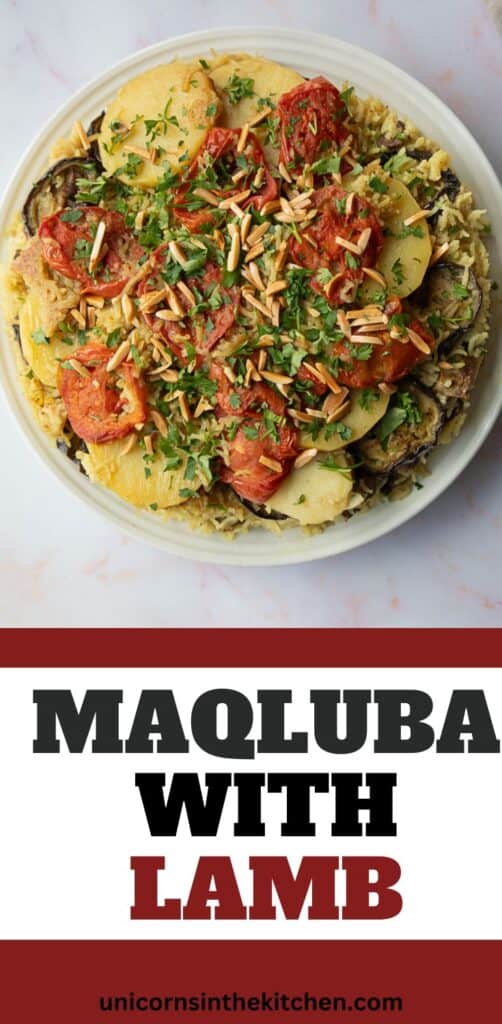
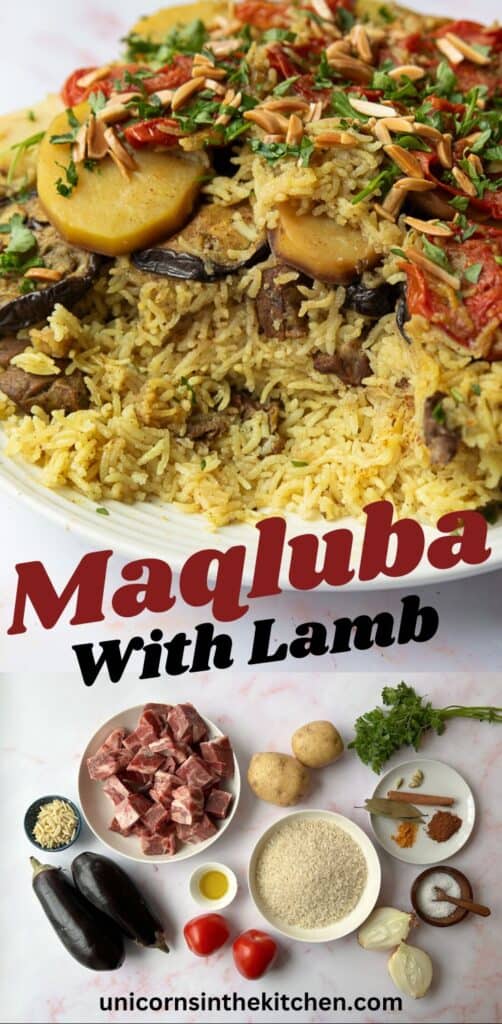
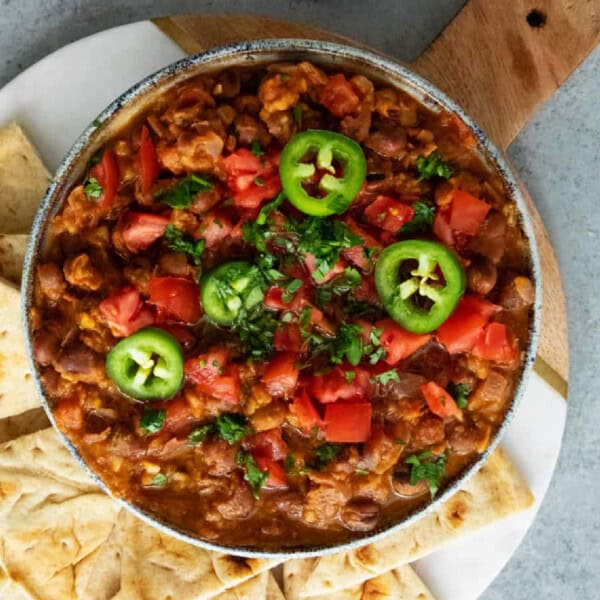

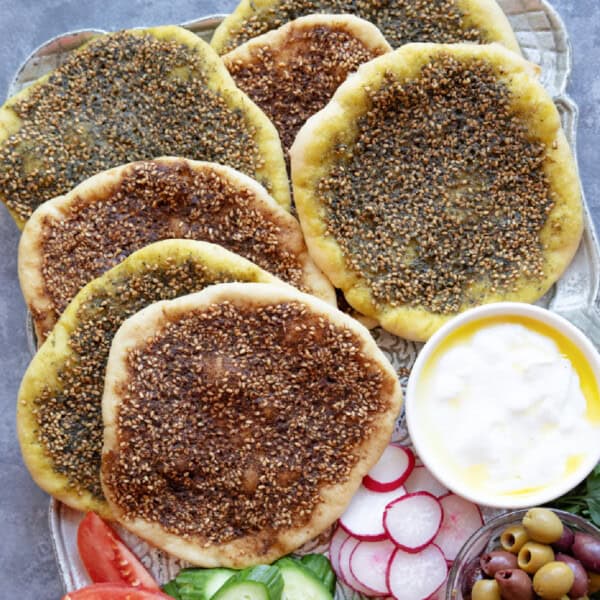
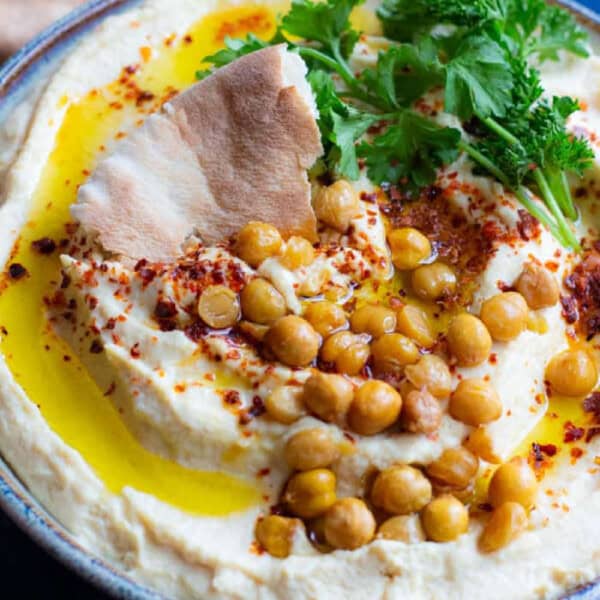









This looks incredible! I cannot wait to make it for dinner this week! Thank you for this awesome recipe!
This dish was amazing. The combination of flavors is fantastic
This was absolutely delicious. The perfect combination of meat and veggies.
I love the concept of this recipe with the flipping. I bet it’s so much fun to make!
The lamb was tender and flavorful, and the layers of rice, vegetables, and spices were perfectly balanced. It’s a great dish to impress guests or enjoy with family.